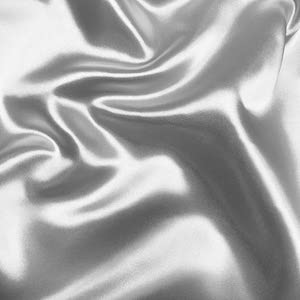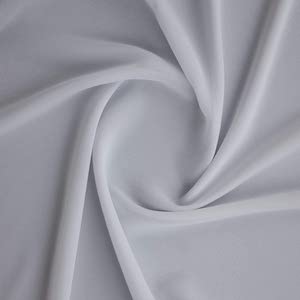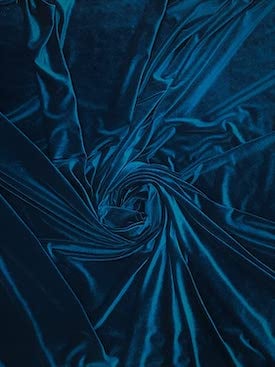When starting a new sewing project, one of the best parts is finding the perfect bolt of fabric. You take a trip to your local fabric store and run your fingers over the different options, comparing patterns and softness.
You’ve probably already noticed that many of the softest fabrics are often made with silk fibers. Whether it’s pure silk, or mixed with other fibers, silk is one of the softest fabric materials on the market.
So, what are the different types of silk fabric? Some of the most notable types of silk fabric are charmeuse, chiffon, organza, taffeta, satin, and more. Each type of silk fabric has its own unique fibers and weaving techniques to produce different looks and feels.
If you’re considering using silk for your next textile project, keep reading. We’ll go over 11 of the most popular types of silk fabric used for clothing, bedding, pillowcases, and more.
How Is Silk Fabric Made?
Most people are aware that silk is made by silkworms, but there’s a lot more to it than that. There are different types of silkworms, and they produce silk under different conditions.
The primary silk creator is the Bombyx mori species in China. These silkworms live on Mulberry trees and eat the leaves. For this reason, the silk is referred to as Mulberry silk. Mulberry silk is responsible for the vast majority of silk fabric on the market – around 80-90% in total.
There are also Tassar silk, Eri silk, and Muga silk. The silkworms that produce Tassar silk are found in a few South Asian countries, while the silkworms that make Eri and Muga silk are found in India.
These other types of silk are not as popular for various reasons. One main issue when it comes to silk production is having enough silk. A single silkworm makes just one strand of silk, and for the textile industry, simply harvesting wild silk won’t make nearly enough for production.
Silkworms produce silk as a substance to wrap themselves in, forming a cocoon. To harvest the silk, the cocoon must be heated to prevent the silkworm from emerging.
Once it’s heated, a silk worker will brush along the cocoon to find the loose end. When a silkworm creates their cocoon, it’s made from one, long strand of silk. So the worker needs to find the end, and can then begin to unravel the single line of silk.
The silk is unraveled onto a reel where it will be combined with other silk strands to form a silk yarn. Once combined, it will be pressed to make it uniform, then woven into fabric.
There are many processes that can take place prior to the final step of fabric weaving to create the different types of silk fabric that we know today. This would also be the time to dye the yarn, so that it creates a colored piece of silk fabric.
11 Types Of Silk
If you do a search for types of silk, you’ll quickly find that there are far too many options to choose from. If every one of these fabrics is made from silk, what’s the difference?
Below, we’ve listed 11 types of the most popular silk fabrics you’ll find. We’ll go into details of what makes each type unique, and what projects suit each fabric type the best.
1. Charmeuse
Charmeuse silk, so named because of the charmeuse weave of the fibers, is one of the most popular and well-known types of silk fabric.
Charmeuse silk is soft and shiny on one side, then matte on the other. This is due to the way the fibers are woven together when creating the fabric.
Because charmeuse has one shiny side and one matte side, it’s an ideal fabric to use on projects where you can hide one side, such as curtains or pillowcases.
It’s also very common in use for blouses, dresses, and other flowy clothing pieces. Charmeuse has a light and flattering drape that makes beautiful apparel. It’s also a popular choice for lingerie.
Charmeuse can be difficult to sew with due to its shiny and slippery surface. Be careful and work closely with the fabric. Smooth it down and pin it as much as you can to ensure smooth seams.
To keep your charmeuse looking beautiful long-term, keep to only a delicate handwash or dry-clean. Delicate charmeuse silk fabric should never be run through the washing machine or dryer.
2. Satin Silk
Satin silk is a type of silk fabric that is often confused with charmeuse. Both of these fabrics have one shiny side and one matte side.
However, the weave process is slightly different for each fabric, resulting in small differences.
The first is that charmeuse tends to be a little shinier than satin. Charmeuse is also a little lighter and softer than satin. These differences are so small that usually people confuse charmeuse for satin and vice versa.
Because satin is like charmeuse, it also makes a nice fabric for pillowcases, curtains, and clothing. It’s specifically nice for bed sheets and evening gowns as well.
Satin is used often in the wedding industry. It gives a bride a nice, shiny look with a soft drape that hugs the figure.
Some artificial satins made with polyester instead of silk can cling against the body due to static electricity. If it’s real satin silk, you won’t have this problem.
3. Organza
You’ve no doubt seen organza throughout your life. This fabric is popular for a variety of projects, from tutus for little girls in ballet to bridal veils for women getting married.
Organza is easily recognized for its stiff texture and drape. This fabric is made by twisting two fibers in opposite directions to create tension in the yarn, then treating the yarn with acid.
Although stiff by nature, organza has a beautiful flow when draped in long evening gowns or bridal veils. It works well as a fabric stuffing, placed in layers underneath a shiny fabric to give the overall silhouette and shape of the garment more volume.
Organza can also be difficult to sew with. It has a netted texture, and whatever seams you run will be visible from the right and wrong sides of the fabric.
To create a hem, we recommend rolling the end and hand sewing with a clean stitch. Try to use a thread that matches closely with the color of the organza fabric to hide it better.
4. Taffeta
Taffeta rose to true fame and popularity in the 1980s. During that decade, taffeta was used in nearly all ladies formal wear, as well as other clothing apparel.
Taffeta is well-known for the shiny look and loud rustle noise it makes as it moves. It’s a stiff fabric, but is also very delicate to work with.
Some taffeta fabrics are made with two different colored threads, creating the iridescent rainbow appearance of some pieces. Most silk fabrics are highly breathable, but not taffeta. This fabric is denser and therefore not as breathable.
Another problem with taffeta is the tendency to wrinkle. To try and smooth out the fabric, you can use a warm iron and steam from the wrong side of the fabric. Don’t lay the iron on the right side of the fabric.
When sewing, one major thing to remember is that once you sew taffeta, you can’t undo it. Taking out any seams in taffeta will show the holes in the fabric.
Make sure you know exactly what you’re sewing and where you’re sewing it before letting the needle hit this fabric.
5. Chiffon
Chiffon can be thought of as the softer, more flowy sister to organza. Like organza, chiffon has a netting-type structure, made by weaving the fibers in a way that you can see through the fabric.
Unlike organza, chiffon is soft to the touch. It has a very smooth, slippery texture and a soft, flowy drape. Chiffon is also used as a layering fabric to create volume. It can be layered underneath another fabric or laid on top, since it has a beautiful look on its own.
It’s commonly used for evening wear, bridal wear, and even blouses or formal shirts. Because it’s so thin, chiffon generally needs another layer of fabric to give it some stability.
Scarves are an exception. They can be made with chiffon without adding any other fabric.
Just as with organza, you’ll need to be careful when sewing. The fabric is slippery and difficult to work with, and any seam you sew will show through on the right side.
6. Crêpe-De-Chine
Crêpe-de-chine, which literally translates to fabric of China, is a lightweight type of silk with a distinctive feel that’s commonly described as “pebbly.”
This feel comes from the weave of the fabric. Crêpe-de-chine silk is made by twisting some of the fibers clockwise and the other fibers counterclockwise, going in opposite directions.
There are different varieties of Crêpe-de-chine, such as Moroccan crêpe and crêpe georgette. All of them have the same basic weave, though, so you’ll always get that pebbly appearance.
This type of silk is very soft and light. It was originally only used for Chinese royalty because it’s such a nice fabric. Over time, it started becoming more common for everyone and not just royalty.
Unlike taffeta, crêpe-de-chine is highly resistant to wrinkles. This feature alone makes this fabric a popular choice for silk apparel.
It’s also breathable, which makes it perfect for evening or formal wear when people tend to sweat under the layers of clothing.
7. Georgette
Georgette silk was named after Georgette de la Plante, a French dressmaker. Also called crêpe georgette, this fabric is a type of crêpe-de-chine, but with its own distinctive features.
Georgette silk is lightweight and made from highly twisted yarns. It has a coarse feel, like chiffon, but is a thicker and heavier fabric that can carry its own weight better than chiffon.
Like chiffon, it still holds that beautiful, soft drape that makes it ideal for evening gowns, dresses, and scarves. It’s also used for blouses.
It doesn’t hold any creases or wrinkles, one of the defining characteristics of crêpe-de-chine silks. Due to its high durability, soft feel, beautiful drape, and lightweight quality, georgette silk is one of the most used silk fabrics.
Georgette silk does snag easily, so be careful when sewing and watch where your garment flows as you walk around a room. Try to avoid running into any doorways or walls in case your fabric snags on a loose nail or splintered wood.
8. Velvet
Another widely known type of silk fabric is velvet. Velvet has long been a popular fabric for lavish curtains, holiday evening wear, and even pillowcases or blankets.
Velvet is most known for its soft, fuzzy feeling. This fuzzy feel is achieved by creating short thread loops densely packed together, then cut to expose their ends. All the ends stick up the same way, creating that soft texture.
The back side of velvet is often matte, and that’s the side you want to work with if you choose to use velvet. You’ll want to sew with a very fine tip needle, and only going in the direction of the natural grain of the fabric.
Ironing should be avoided completely. To fix any wrinkles or creases, simply hang it in a bathroom with a hot shower running or use a steamer. Running an iron on top of the velvet, or even underneath, can burn or smush the soft, fuzzy texture.
9. Raw Silk
In the silk production process, there is a substance that naturally occurs on the silk cocoon which is removed. This substance is called sericin, or silk gum. It helps the silk stay together in a cocoon around the silkworm.
The sericin is melted or washed away during silk production, so that the silk is clean and free of this substance.
Raw silk, however, does not remove the sericin. Since the silk gum remains on the fibers, the yarns that are made from the silk strands are generally uneven.
Raw silk fabric has a beautiful sheen, though, with a highly lustrous look. It’s incredibly soft and smooth to the touch.
Since raw silk still retains that gum substance, it’s easier to sew and less slippery in a machine. It’s great for making any clothing apparel, from dresses and shirts to skirts and pants.
10. Spider Silk
Although silk is mainly produced by silkworms, there are also silk fabrics made from the silk that spiders produce to spin their webs.
Spiderwebs are so durable that they stand up to wind, rain, and snow. This high durability translates to an incredibly strong fabric, ranking up there with the strength of high-grade alloy steel.
Spider silk is tough to find, since it’s much more difficult to extract and process in large quantities. But if you can get your hands on some spider silk fabric, you’ll have a highly durable and smooth fabric that’s great for any use.
11. Sea Silk
There’s one other animal that produces silk, and that’s a mollusc, or mussel. There’s a specific type of mussel in the Mediterranean that secretes a filament to attach its shell to the bottom of the sea floor.
If you thought spider silk was hard to find, sea silk is even more difficult to find. If you can find it, the price is through the roof!
Still, this type of silk fabric is incredibly soft and worth it, if you can find it.
Up Next: Is Silk Stretchy? – The Ultimate Guide









